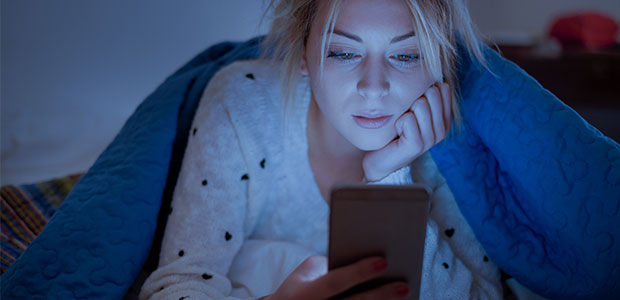
Page 2 of 2
Blue Light: What is it and How Does it Affect Us?
Our eyes are continually taking in various forms of light—most of it blue light from screens. We look at our phones before the sun comes up in the darkness of our rooms. We look at computers and tablets at work all day. We come home and watch television. Then we lay in bed looking, again, at our phones long past the sun goes down. What’s in those lumens we take for granted, and how do scientists think it’s affecting our health?
A lot of it has to do with the body’s biological clock, or the circadian rhythm. Our sleep can often get thrown off because of the amount of screen time we have each day. And what’s worse, sleep issues may contribute to the causation of many health concerns like cancer, diabetes, heart disease, and obesity.
Harvard Health Publishing breaks down what blue light is, what kind of exposure is worse than others, the effects it has on sleep, LED light, and how to change your habits for the better.
What is Blue Light?
Have you ever thought of light having a certain colored wavelength? Blue light is exactly that: light with blue wavelengths—which are supposedly beneficial during daylight hours because they boost attention, reaction times, and mood. However, these lights are great for the daytime because they keep us awake, and bad at night because they often impede sleep. The proliferation of electronic screens, as well as energy-efficient lighting, is increasing exposure to blue wavelengths, especially after the sun goes down.
Light and Sleep
No one’s circadian rhythm is the same as someone else’s, but on average, most people’s are about 24 and one-quarter hours. Individuals who stay up late typically have slightly longer ones, while early risers usually fall short of 24 hours. Before the recent influx of electronic screens in 1981, though, a person’s internal clock mostly aligned with the environment, said Dr. Charles Czeisler of Harvard Medical School.
Light Exposure at Night
You might be wondering about how cancer, diabetes, and other concerning health problems tie into the conversation of light. Well, a lot of research is preliminary and needs more information. However, there are some things to be mindful of.
Some studies do suggest a link between exposure to light at night, such as working the night shift, to health problems. However, that is not proof that nighttime light is bad for us or causes these conditions.
We do know, though, that exposure to light suppresses the secretion of melatonin—a hormone that influences circadian rhythms, and there is some preliminary data that suggests a lower melatonin level might explain the association with cancer.
On diabetes and obesity, the Harvard study researchers put 10 people on a schedule that gradually shifted the timing of their circadian rhythms. As a result, their blood sugar increased which put them in a prediabetic state, and levels of leptin (a hormone that makes you feel full after eating) went down. These major changes can surely alter a person’s eating and hunger habits, as well as blood sugar levels, meaning that diabetes and obesity really might have something to do with light exposure.
The study also said that dim light can interfere with a person’s circadian rhythm and melatonin secretion. A mere eight lux (level of brightness exceeded by most table lamps about twice that of a night light) has an effect, said Stephen Lockley, a Harvard sleep researcher. He agreed that light at night is a major reason people do not get enough sleep at night, and lack of sleep can affect a number of things like job performance, energy levels, eating habits, and mental health.
Blue Light Exposure at Night
Any light can affect your sleep at night, but blue light can be especially harmful because of its ability to suppress melatonin levels. Harvard researchers conducted a study to measure blue light’s effect on melatonin levels:
They compared the effects of 6.5 hours of exposure to blue light to green light of comparable brightness. The blue light suppressed melatonin for about twice as long as the green light and shifted circadian rhythms by twice as much (3 hours vs. 1.5 hours).
In another study, researchers at the University of Toronto compared the melatonin levels of people exposed to bright indoor light who were wearing blue-light-blocking goggles to people exposed to regular dim light without wearing goggles. The hormone levels were about the same in the two groups, which strengthens the hypothesis that blue light is a potent suppressor of melatonin. According to Harvard, it also suggests that people who are exposed to blue light at night (like shift workers and night owls) could maybe protect themselves if they wore eyewear that blocks blue light—and are there are plenty of those products on the market.
LED Blue Light Exposure
If blue light does have health effects, then the quest for energy-efficient lighting could be at odds with personal health. This is because LED lightbulbs are definitely more energy-efficient than the old-fashioned incandescent lightbulbs, but they also tend to produce more blue light.
Tips for Blue Light at Night
Here are a couple of helpful tips for you to minimize your exposure to blue light to better your chances of good health and consistent sleep routines:
- Use dim red lights for night lights. Red light has the least power to shift circadian rhythm and suppress melatonin.
- Avoid looking at bright screens beginning about two to three hours before bed.
- If you do work a night shift or use electronic devices at night, consider wearing blue-blocking glasses or installing an app that filters the blue/green wavelength at night.
- Expose yourself to a lot of bright light during the day, which will help your ability to sleep at night, as well as your mood and alertness during the day.